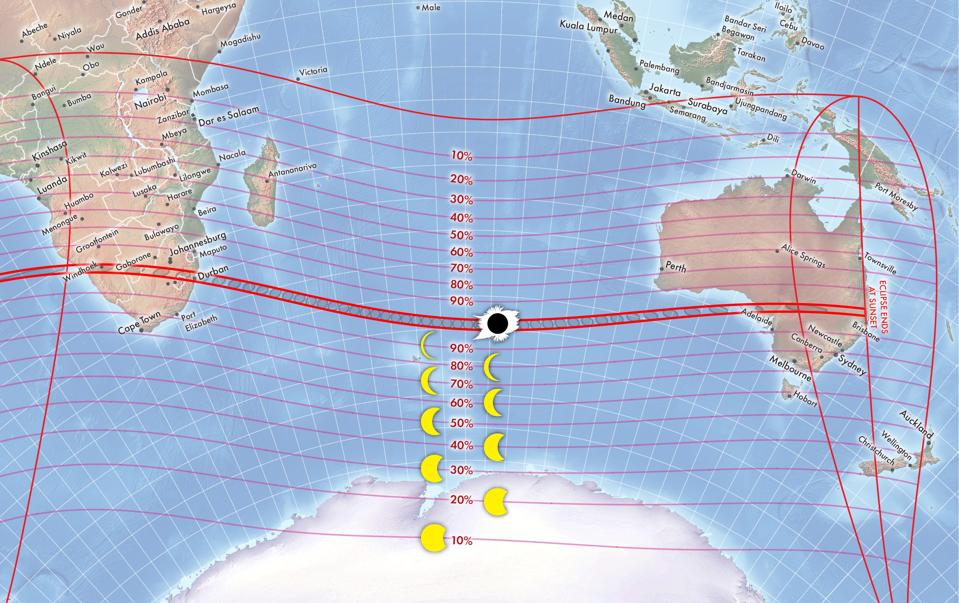It’s one of the shortest totalities of the decade, but for eclipse chasers after a stargazing and safari experience on top of a total solar eclipse, Nov. 25, 2030, is a date to circle in the diary.
Like most total solar eclipses, this event takes place mainly over the ocean, but at either end of the 9,033-mile (14,538-kilometer) path of totality, some thrilling experiences are possible in southern Africa and Australia. With careful planning, you can catch totality among sand dunes, game parks and the Outback.
2030 Total Solar Eclipse: Path Of Totality In Africa
The eclipse begins shortly after sunrise on Namibia’s Skeleton Coast, where the moon’s shadow races inland. At Cape Cross Seal Reserve, thousands of fur seals will jostle in early morning light as totality hits at just 13.5 degrees above the eastern horizon. Zoologists and eclipse lovers alike may witness strange animal behavior as darkness briefly falls for 1 minute and 34 seconds. For a longer show and a higher chance of clear skies, head inland where the chance of cloud hovers around just 20%, including in the capital, Windhoek, Namibia’s capital.
Botswana’s Kgalagadi Transfrontier Park offers a unique combination: 2 minutes and 9 seconds of totality — if you travel slightly north of the park center — plus a prime chance to see springbok, wildebeest and the famed Kalahari lions. There’s just a 25% chance of clouds.
That changes to a worrying 67% for Durban, South Africa, by far the most populous place to experience this eclipse. Here, over 2 minutes of totality will darken the city’s beaches and skyline.
2030 Total Solar Eclipse: Path Of Totality In Australia
After crossing the Indian Ocean mostly unseen, totality resurfaces in southern Australia, where sunset eclipses will thrill observers in the Outback. At Ikara-Flinders Ranges National Park in South Australia, you’ll experience nearly 2 minutes of totality at the end of the day.
Those in Queensland’s remote Currawinya National Park — and particularly the rural town of Surat — will see a stunning eclipsed sun setting low on the western horizon.
When Is The Next Total Solar Eclipse?
On Aug. 12, 2026, a total solar eclipse will be visible from parts of Greenland, western Iceland and northern Spain. It will be the first total solar eclipse to cross mainland Europe since 1999, with a maximum duration of 2 minutes and 18 seconds off the coast of Iceland. Cruise ships are expected to gather in the fjords of Greenland and Iceland, while northern Spain offers the best chances of clear skies — though the eclipsed sun will be low in the sky, making open horizons essential. North America will see only a minor partial solar eclipse.
Then, on Aug. 2, 2027, a much longer and more dramatic event will occur. Known as the longest totality of the century, this eclipse will last up to 6 minutes and 22 seconds over Luxor, Egypt. The path of totality will also cross southern Spain, northern Morocco, Algeria, Tunisia, Libya, Egypt, Yemen and Saudi Arabia. It will be one of the most widely viewed eclipses of the decade.
When Is The Next Eclipse In North America?
The next total solar eclipse in the U.S. will be in Alaska, which will see a 2-minute 37-second totality on Mar. 30, 2033. The Last Frontier state will experience totality for up to 2 minutes and 37 seconds during the best time of the year for Northern Lights. Places in the path of totality will include St. Lawrence Island, Barrow (also known as Utqiagvik), Kotzebue, and Nome.
The next total solar eclipse in the contiguous U.S. will occur on Aug. 23, 2044, and be visible near sunset in Montana and the Dakotas. However, Banff and Jasper National Parks in Alberta, Canada, will likely be where most eclipse chasers travel. One lunar year later, on Aug. 12, 2045, a total solar eclipse will be seen from 13 U.S. states, with totality peaking at over six minutes in Florida.
Wishing you clear skies and wide eyes.

